Granular leukocytes - Study guides, Class notes & Summaries
Looking for the best study guides, study notes and summaries about Granular leukocytes? On this page you'll find 217 study documents about Granular leukocytes.
All 217 results
Sort by
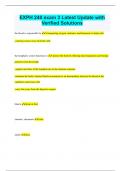
-
EXPH 240 exam 3 Latest Update with Verified Solutions
- Exam (elaborations) • 42 pages • 2024
- Available in package deal
-
- $10.99
- + learn more
EXPH 240 exam 3 Latest Update with Verified Solutions the blood is responsible for -transporting oxygen, nutrients, and hormones to body cells -carrying wastes away from the cells the lymphatic system functions to -protect the body by filtering microorganisms and foreign particles from the lymph -support activities of the lymphocytes in the immune response -maintain the body's internal fluid environment as an intermediary between the blood in the capillaries and tissue cells -car...

-
BSC 2086 Exam 1 Questions with complete solutions
- Exam (elaborations) • 13 pages • 2024
-
- $13.99
- + learn more
Lymphocytes and monocytes are granular leukocytes. (T or F) Correct Answer-False Platelets are derived from this large precursor cell Correct Answer-megakaryocyte In the clotting process blood cells are trapped in this Correct Answer-fibrin threads Erythropoietin, a hormone that stimulates production of red blood cells, is produced by the kidneys. (T or F) Correct Answer-True Which of the following is not a type of white blood cell? Correct Answer-Thrombocyte The volume of blood e...

-
Immunology Study Questions and Answers 2024 Graded A
- Exam (elaborations) • 69 pages • 2024
-
- $15.49
- + learn more
Examples of pathogens that cause human disease include: a. bacteria b. viruses c. fungi d. parasites (protozoans and worms) e. All of the above - e. All of the above Which of the following is not associated with mucosal surfaces? a. mucus-secreting goblet cells b. lysozyme c. M cells d. beating cilia e. white pulp - e. white pulp One reason that pathogenic microorganisms have an advantage in the host they infect is because they: a. have previously been encountered th...
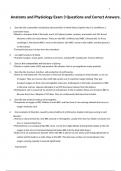
-
Anatomy and Physiology Exam 3 Questions and Correct Answers.
- Exam (elaborations) • 15 pages • 2024
-
- $12.99
- + learn more
Anatomy and Physiology Exam 3 Questions and Correct Answers. 1. Describe the composition and physical characteristics of whole blood. Explain why it is classified as a connective tissue. Blood is a transport fluid of the body, and is 55% plasma (water, proteins, and waste) and 45% forced elements, which are much denser. These are the RBC’s (millions) and WBC’s (thousands). So if you centrifuge it, the densest RBC’s move to the bottom, the WBC’s move to the middle, and the plasma ...
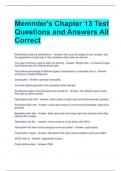
-
Memmler's Chapter 13 Test Questions and Answers All Correct
- Exam (elaborations) • 10 pages • 2024
- Available in package deal
-
- $13.49
- + learn more
Memmler's Chapter 13 Test Questions and Answers All Correct White blood cells are identified by: - Answer- their size, the shape of their nucleus, and the appearance of granules in the cytoplasm when cells are stained. The stain commonly used to stain the blood is - Answer- Wright stain - a mixture of dyes that differientiate the different blood cells The relative percentage of different types of leukocytes is a valuable clue in - Answer- arriving at a medical diagnosis Granlocyt...
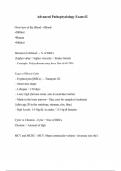
-
Advanced Pathophysiology Exam #2
- Exam (elaborations) • 77 pages • 2024
-
- $11.00
- + learn more
Overview of the Blood - •Blood •5000ml •Plasma •3000ml Hematocrit defined - - % of RBCs [higher value = higher viscosity = thicker blood) - Example: Polycythemia may have Hct of 60-70% Types of Blood Cells - Erythrocytes [RBCs) - - Transport O2 - Small disc shape - Lifespan = 120 days - Carry Hgb [ferrous oxide, also an acid/base buffer) - Made in the bone marrow - Iliac crest for sample in leukemia [after age 20 in the vertebrae, sternum, ribs, iliac) - Hgb Levels: 14-16g/...
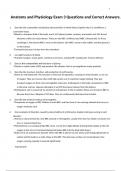
-
Anatomy and Physiology Exam 3 Questions and Correct Answers.
- Exam (elaborations) • 15 pages • 2024
-
- $12.99
- + learn more
Anatomy and Physiology Exam 3 Questions and Correct Answers. 1. Describe the composition and physical characteristics of whole blood. Explain why it is classified as a connective tissue. Blood is a transport fluid of the body, and is 55% plasma (water, proteins, and waste) and 45% forced elements, which are much denser. These are the RBC’s (millions) and WBC’s (thousands). So if you centrifuge it, the densest RBC’s move to the bottom, the WBC’s move to the middle, and the plasma ...
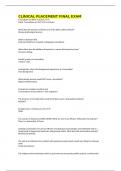
-
CLINICAL PLACEMENT FINAL EXAM
- Exam (elaborations) • 24 pages • 2024
-
- $10.59
- + learn more
CLINICAL PLACEMENT FINAL EXAM Transudates are RICH in protein. (T/F) FALSE. Transudates are NOT rich in proteins. What does the presence of fluid in any of the body cavities indicate? Disease/pathological process. Define a dialysate fluid. Peritoneal fluid from a patient undergoing renal dialysis. What effect does the addition of heparin to a serous fluid specimen have? Prevents clotting. Specific gravity of a transudate. 1.005 to 1.015 Cytologically, what is the b...
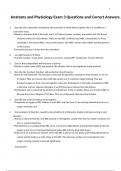
-
Anatomy and Physiology Exam 3 Questions and Correct Answers.
- Exam (elaborations) • 15 pages • 2024
-
- $12.99
- + learn more
Anatomy and Physiology Exam 3 Questions and Correct Answers. 1. Describe the composition and physical characteristics of whole blood. Explain why it is classified as a connective tissue. Blood is a transport fluid of the body, and is 55% plasma (water, proteins, and waste) and 45% forced elements, which are much denser. These are the RBC’s (millions) and WBC’s (thousands). So if you centrifuge it, the densest RBC’s move to the bottom, the WBC’s move to the middle, and the plasma ...
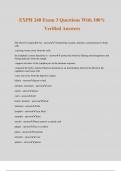
-
EXPH 240 Exam 3 Questions With 100% Verified Answers
- Exam (elaborations) • 17 pages • 2024
-
- $12.49
- + learn more
EXPH 240 Exam 3 Questions With 100% Verified Answers The blood is responsible for - answer-transporting oxygen, nutrients, and hormones to body cells -carrying wastes away from the cells the lymphatic system functions to - answer-protect the body by filtering microorganisms and foreign particles from the lymph -support activities of the lymphocytes in the immune response -maintain the body's internal fluid environment as an intermediary between the blood in the capillaries and tissue c...

How much did you already spend on Stuvia? Imagine there are plenty more of you out there paying for study notes, but this time YOU are the seller. Ka-ching! Discover all about earning on Stuvia


